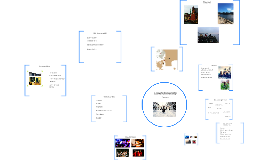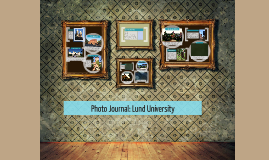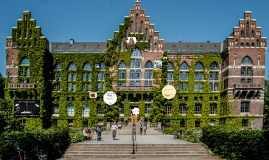Photo Journal: Lund University
Transcript: This building was originally Built as a hospital in 1867. It now functions as the graduate school for the psychology institute, and the old hospital chapel serves as the lunch room. Palaestra Lund University promotes a sustainable lifestyle for their students with a combination of a walkable campus and abundant bike parking. Nature The University Building This was the first building constructed for Lund University, built as a library . At this time the university was surrounded by a wall, enclosing the buildings and a green space. This was not only to give the students a quiet and secluded study area, but also to keep out the beggars and loose pigs that roamed the town. The second building to be built for the university, King's house was originally used as classrooms. It was the last building to be built for the next 200 years. Tegner The university used to have a monastery, however when the building was taken down the University found a sustainable use for the ruins. Townspeople were allowed to take stones from the rubble in order to use in their own homes and in other buildings of the University. This prevented the use of more natural resources, and was definitely a form of recycling. Lund University First Building Kings House The church of Lund was built in 1100, while the town was still part of Denmark. The church was a large factor in the decision to build the university in Lund, as it provided an already established place for religious studies Student Organizations Cathedral The Lund Campus is integrated with the nature of the town. Trees on the campus are planted in straight rows to help organize the university. This planning contrasts the unorganized nature of the winding streets of the town. The University building is home to the principals office as well as other members of the university administration. It is also where students of the international program come for a welcome reception after their arrival, as well as where they attend a ceremony to receive their PhDs. This building is planned smartly to be the entrance and exit for students of the university. Bikes Photo Journal Summer 2013 Emily Wheeler Lund, Sweden This university has proven to be a sustainable campus as the university has continuously chosen to remodel it's historic buildings, rather than building costly and wasteful new ones, except when necessary for expansion. This is an example of true preservation at it's finest. Additionally the University maintains a walkable campus where students can safely bike. This statue is of the main bishop in Lund during the time of the Universtiy's beginnings, Tegner. He had a large influence on the development of Swedish Society. After the final war between Denmark and Sweden made the school lose support, Tegner was a large force that kept the university from closing. Old Hospital This building was originally built for student housing and as a recreation area for the abundant coffee culture of Lund. Now it is used as an office building for organizations within the university, such as the Student Union. Photo Journal: Lund University This building provides the students with plenty of places to study, and in order to sustain the history and keep the building, rather than creating a new library the university has simply added on more space to the back of this building as the school grows. Palaestra was used as the university gymnasium until the 1980s when there was a fire. Instead of demolishing the building, the university repaired the inside. This sustainable act saved the university money as well as resources. Old Monastary University Library

















